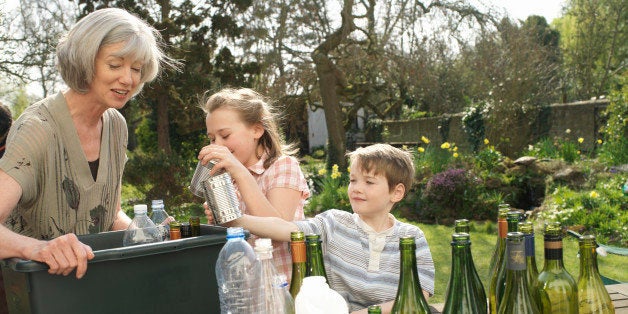
Everyone wants to raise healthy, responsible children. We hope our offspring will grow up with compassion and a desire to leave the world a better place. How do we foster these qualities in young children whose primary thought is getting their immediate needs met?
Their curious nature makes them perfect candidates to introduce a green lifestyle that will preserve our resources and create a cleaner earth. With a few simple tips you can develop habits that instill an appreciation for the environment for a lifetime.
Reduce plastic use. Plastic does not biodegrade, it photo degrades, which means it breaks down into thousands of tiny smaller particles but never fully disappears. Much of this plastic is blown into the sea from land and gets caught in gyres, rotating ocean currents like giant whirlpools. Because plastics and trash cannot escape these currents they are often stuck in the gyres forever, turning them into an immense garbage patch of plastic soup.
Fish mistake these particles for food and ingest them which release toxic chemicals. Humans consuming fish may also suffer adverse effects from the pollutants and toxins.
Children can reduce plastic by incorporating a trash-free lunch. Buy your child an eco-friendly lunch bag and reusable water bottle. Invest in fabric snack bags to replace Ziploc bags. Send them to school with their own utensils and cloth napkins.
Shop locally. Besides being pumped full of chemicals, processed foods require more energy to produce. Grapes coming from Chile must be packaged in a factory and flown out. Then trucks transport them to stores. Snow peas from China travel 7,000-8,000 miles to get to our homes. Importing, whether by ship or air, contributes to air pollution and global warming. Approximately 950 cases of asthma, 16,870 missed school days, and 37 premature deaths could be attributed to the declining air quality from food imports in California according to the freight transport-related projections by the California Air Resources Board.
Many supermarkets are now labeling the origins of produce. Look for labels in the store or on the product itself and shop locally when possible.
Farmers markets are fantastic. Food is grown locally and picked when ripe, usually using little or no pesticides. Community Supported Agriculture programs (CSAs) are another way to support local farmers by buying a "share" of their crops. Joining a CSA gives access to fruit and vegetables boxes that are delivered to homes or picked up at a nearby location. Search Local Harvest to locate a farmers market or CSA near you. Growing a garden is wonderful way to eat locally. Even the smallest of yards or patios can harvest herbs and container plants. Let children pick their own fruit and vegetables. Get them involved in cooking. Kids are more likely to eat food they have selected and help prepare.
Unplug. According to the U.S. Department of Energy electrical devices can sap up to 10 percent of your electricity. Unplugging items like chargers, toasters, coffeemakers, and lamps that are not in use can make a dent in offsetting global warming. Give children the task of making post-its to place near these devices as reminders. Assign your child the task of unplugging electronics as part of their daily chores.
Make Mondays meatless. Greenpeace reports the majority of the Amazon rainforest is being destroyed for cattle ranches that are used for human consumption. In South America more than 85 percent of deforestation results from agriculture. A report from The United Nations revealed that cattle release more global warming emissions (methane gas) than transportation. Food and the pesticides used to produce animal feed contribute even further to global warming. Consuming one less meat meal a week would have a large effect on climate change.
Involve children in creating a weekly meatless meal. Set up a burrito bar with beans, rice, veggies, and salsa. Make your own pizza with topping stations. Or have a breakfast buffet with pancakes and various toppers. Give your child a say in what type of pasta and sauce they want for their meat-free meal.
Encourage kids to reuse. Unfortunately much of what goes into our curbside bins does not get recycled. Algalita Marine Research Institute, a research group based in Long Beach, estimates less than 5 percent of items in these containers are actually recycled. The recycling symbol is a misconception. The presence of the logo does not mean that it will be recycled, only that it can be recycled.
Reusing can be a great alternative to recycling. Glass jars and plastic containers make great storage for puzzle pieces, hair accessories, crayons, paper clips, or any small toy in your child's room. Establish a box where children can collect lids, stir sticks, packaging, paper towel rolls or anything you would normally throw out. Let this be an art center to create collages, villages, buildings, fairy gardens or whatever their imagination can conceive. When left to explore, children will be much more creative than most adults.
The best gift we can give our children is a world a little cleaner and a little healthier than they came into. Part of that gift includes establishing an appreciation for our environment, an awareness that what we take also needs to be returned or replaced. Young minds have open hearts and this is the perfect time to instill lifelong values.
Dawn Wynne is a best-selling author, public speaker, health coach and environmental activist based in Palos Verdes Estates. Her latest book is Earth Remembers When ... an environmental book for children which can be found at dawnwynne.com.